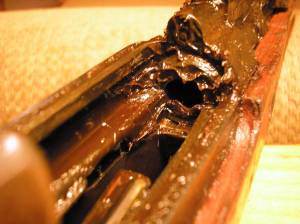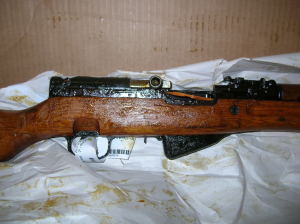If you are considering burying or stashing metal object…like say firearms; think about picking some of this up or a similar product for long term metallic preservation. Everyone who has served in the military is familiar with this sticky nasty stuff that new weapons and parts are shipped in. When I bought our wheat grinder some time ago several steel parts were covered in a similar goop as have other tools and metal objects that were shipped to me.
Cosmoline is the genericized trademark for a generic class of rust preventives, typically conforming to United States Military Standard MIL-C-11796C Class 3, that are a brown colored wax-like mass; have a slight fluorescence; and has a petroleum-like odor.
Chemically, cosmoline is a homogeneous mixture of oily and waxy long-chain, non-polar hydrocarbons. It is always brown in color, but can differ in viscosity and shear strength. Cosmoline melts at 113–125 °F (45–52 °C) and has a flash point of 365 °F (185 °C).
Its most common use is in the storage and preservation of some firearms, hand tools, machine tools and their tooling, and marine equipment. Entire vehicles can be preserved with cosmoline. Notable Egyptologist Dr. Zahi Hawass recently disclosed that ancient Egyptian mummification practices from the third to fifth dynasties utilized a chemical compound molecularly similar to cosmoline.
During World War II, U.S. Coast Artillerymen (serving the huge coastal artillery batteries) were known as “Cosmoliners” because they were tasked with the near constant cosmoline application (“greasing down”) of the guns. Cosmoline was also used to coat weapons, including entire tanks, for long sea voyages, as it prevented rust even in salty conditions.
During Pacific island campaigns in World War II, the United States Marines sang a song about cosmoline. Adapting the popular big-band tune Tangerine they would sing “Cosmoline…keeps my rifle clean”. Despite this, most servicemen found Cosmoline bothersome to remove; many felt that Cosmoline was not only for preserving the weapon and preventing rust but also for making soldiers’ lives miserable.
Cosmoline that is fairly fresh, or that has been hermetically sealed in a plastic bag or shrink wrap, remains a grease-like viscous fluid, and mostly wipes off with a rag, leaving only a thin film behind. Cosmoline that is older and has had air exposure usually solidifies after a few years, as the volatile hydrocarbon fraction evaporates and leaves behind only the waxy hydrocarbon fraction. The solid wax does not readily wipe off. It can be scraped off, although the scraping is laborious and leaves crumbs to be swept or vacuumed away. A useful method of cleaning a tool of crusted cosmoline is to allow a penetrating oil (such as WD-40, CRC 5-56, CLP, or equivalent) to soak into it for several minutes or hours, which typically restores it to a viscous-fluid state, allowing it to be wiped off. An additional method of cosmoline removal on new parts is to use a closed-cabinet parts washer that utilizes the power wash process. Removal of cosmoline with an aqueous parts washer requires high heat, the proper aqueous detergent, and the correct hydraulic impact pressure. Most of these “washing” methods will create a difficult-to-dispose-of toxic sludge.
Jon
http://en.wikipedia.org/wiki/Cosmoline




Hi Jon,
We just wanted to thank you for spreading the good word. Love your post on our Cosmoline protective coatings. Please contact me directly if there’s anything we can help you with.
Have a great day!
Brad
Sales Guy
http://www.CosmolineDirect.com
I love the sight, and thanks for the feedback. I hope my little blurb points a few people in the right direction.
Jon